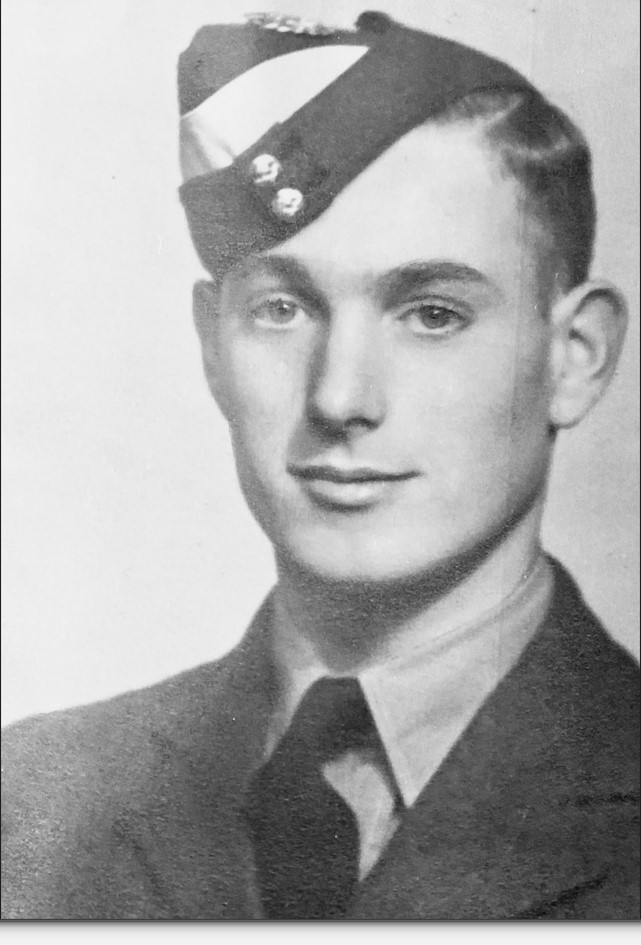This post is one in a series of posts on the crash of an Armstrong Whitworth Whitley Z9362, which crashed into the sea 2-miles from Saltcoats Harbour on the 2nd of May, 1943. The portrait photograph of Sergeant Edward Dyer in uniform shown above was provided by Vera and Jim Duncan.
Sergeant Edward Harold George Dyer (Service Number 1606353, Air Gunner)
Shortly before Whitley Bomber Z9362 crashed into the sea two miles off Saltcoats harbour on Sunday 2nd May 1943, Sergeant Edward Harold George Dyer baled out from the rear turret and came down on dry land. He was walking over the road bridge at Saltcoats railway station when he met local boy John McCallum and his father who had been awoken in their house in Parkend Road by shouts for help from Sgt Leslie Noel Atkinson who had parachuted into the sea. They spoke briefly, with Sgt Dyer explaining that he had escaped from a stricken Whitley Bomber and asking for directions to the police station which was only a short walk away in Green Street. Although it was a very brief encounter, John McCallum’s recollection of the details of this conversation provided enough information for the tragic event to be fully researched and pieced together almost 80 years later.
RAF Form 765c – Report on Flying Accident or Forced Landing for Whitley Z9362 recorded the following details: ‘From information supplied by Sgt Dyer, who was in the rear turret, it is suggested that the port engine developed a coolant leak and then failed, the failure of the starboard engine approximately half an hour later being probably due to pilots attempting to keep the aircraft in the air on one engine. No investigation possible – aircraft in sea’
The initial reason for carrying out the research on the Whitley Bomber crash was to try to reunite Sgt Dyer with John McCallum. Sadly, one year into the research it was found that he had been killed in action over Holland on the night of 22nd/23rd November 1943 at the age of 19 years. This happened just over six months after the chance meeting on the road bridge at Saltcoats railway station. Sgt Dyer’s niece, Vera Duncan, and her husband Jim carried out extensive research on him over many years. The photograph below shows a story board which they created to let people know about his service in the Royal Air Force (RAF). This was displayed at family history roadshow events in about 2012 which were open to the public, but not previously published on-line.
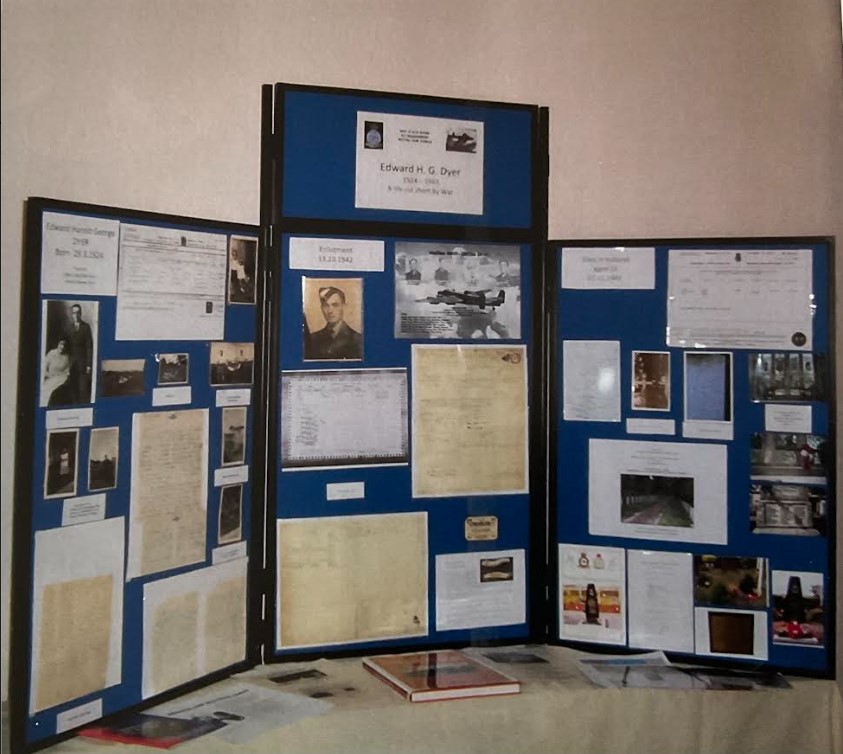
They have written the following account about him, which includes information about his family and service life, his loss, and the memorials which will remind future generations of the ultimate sacrifice that he made. In the following paragraphs, Vera refers to Sgt Edward Dyer as her Uncle Ted:
Ted was born in the market town of Cullompton in Devon in 1924. He was a country lad, and enjoyed shooting with his best friend Jack Mills. His parents were pleased that he and his sister Patsy (my mother) both passed their 11 plus exams and went on to grammar school, being rewarded with new bikes.
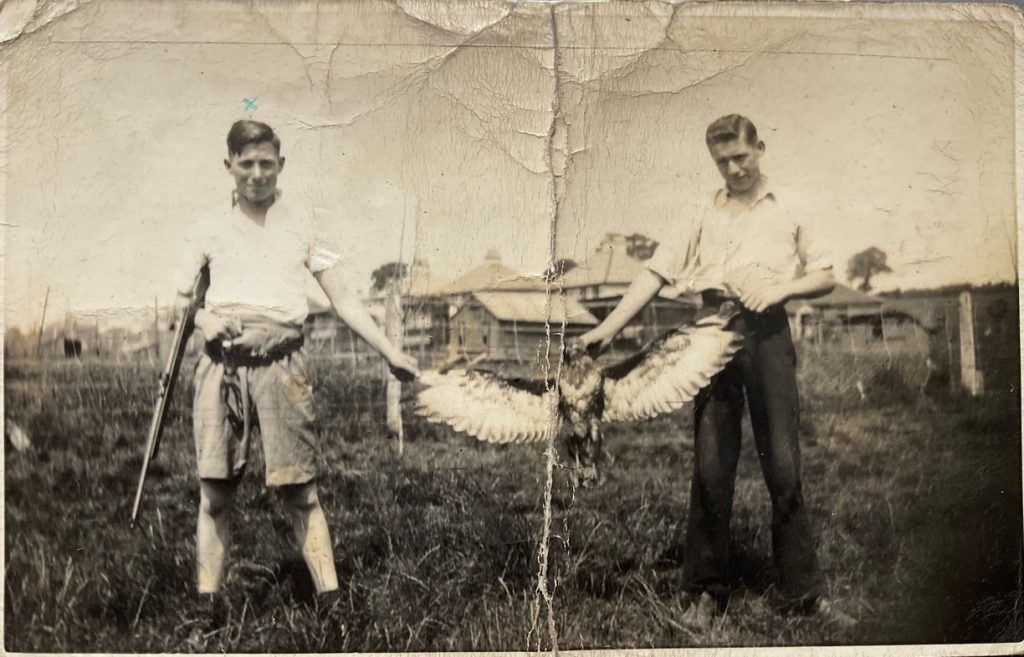
Uncle Ted enlisted in the October of 1942, training to be an air gunner in the Royal Air Force Volunteer Reserve. The description section on RAF Form 543, shows he was short in height at 5 feet 6 inches, chest 33 inches with auburn hair, blue eyes and a ruddy complexion (a Dyer family trait).
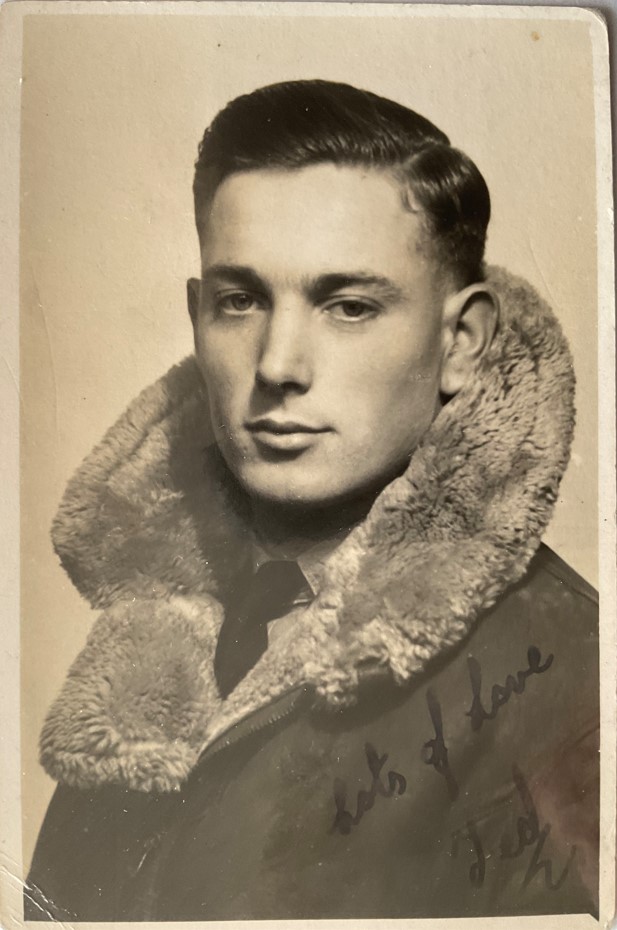
His record, though short, shows he went through various training units for 12 months, one of which was the 24 Operational Training Unit based at RAF Honeybourne in March 1943, on the Armstrong Whitworth Whitley Bomber Mark V aircraft.
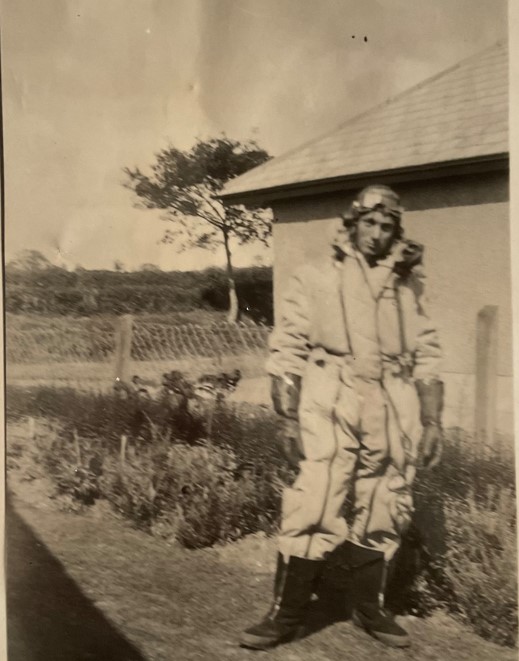
A Caterpillar Pin and Certificate of Membership of the Caterpillar Club were awarded to him. These were given to anyone who saved their own life by parachuting from a disabled or flaming aircraft. His sister (my Mum) could not remember where or when Uncle Ted received this. It was only in September 2023 that the question was finally answered, thanks to the help of Ian McCallum and his father John, and North Ayrshire Heritage for the information on the crash off the coast of Saltcoats on 2nd May 1943, for which I am very grateful.
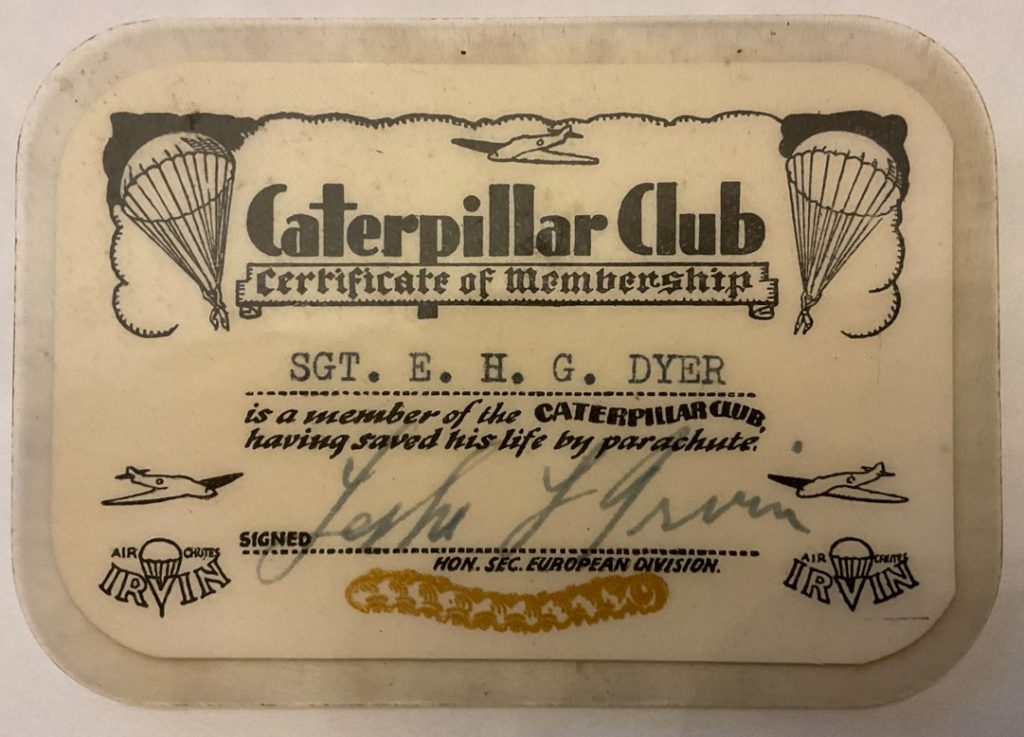
In June of the same year he was transferred to 1663 Heavy Conversion Unit, based at RAF Rufforth, North Yorkshire. Only a few weeks later he was posted to 51 Squadron at RAF Snaith, Yorkshire.
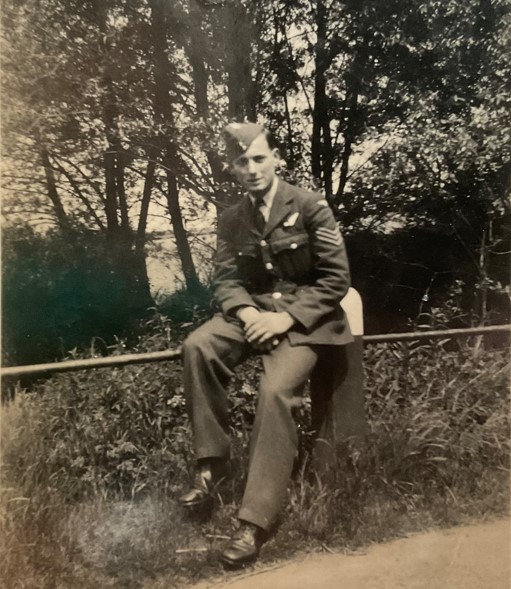
After his posting to 51 Squadron, his records reflect that he only was involved in two operational flights before his final mission on the 22nd November 1943 to Berlin. His first mission was on the 11th November to Cannes and the second to Leverkusen on the 19th November. The following extract from the Operations Record Book (ORB) for 51 Squadron, November 1943 recorded details of his final flight.
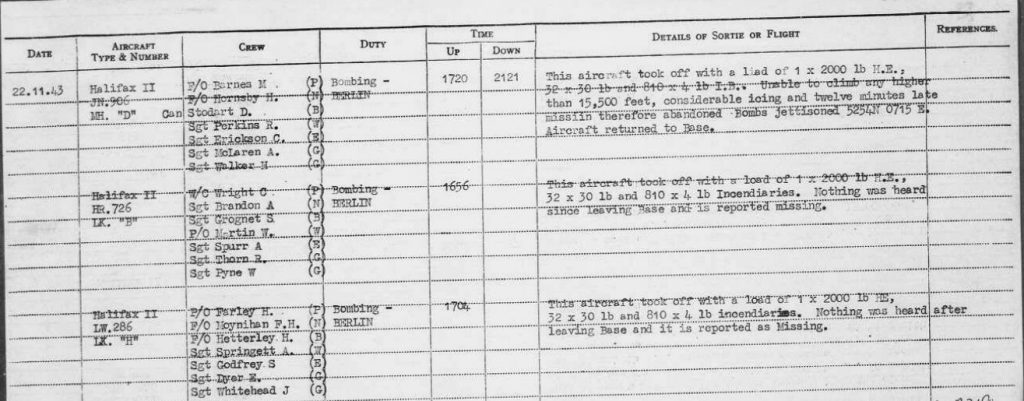
The ORB describes Uncle Ted’s flight as follows:
The flight commenced at 17:04 on Monday 22nd November 1943. The ORB states: “This aircraft took off with a load of 1 x 2000 lb HE, 32×30 lb and 810 x 4lb incendiaries, target Berlin. Nothing was heard after leaving base and it is reported as missing” (abbreviations HE = High Explosive; Ib = pound (weight))
The following ‘Summary of Events’ extract from Page 3 of the ORB AIR27/492/39 for 51 Squadron, November 1943 (provided by Vera and Jim Duncan) shows the post operational report for Monday 22nd November 1943.
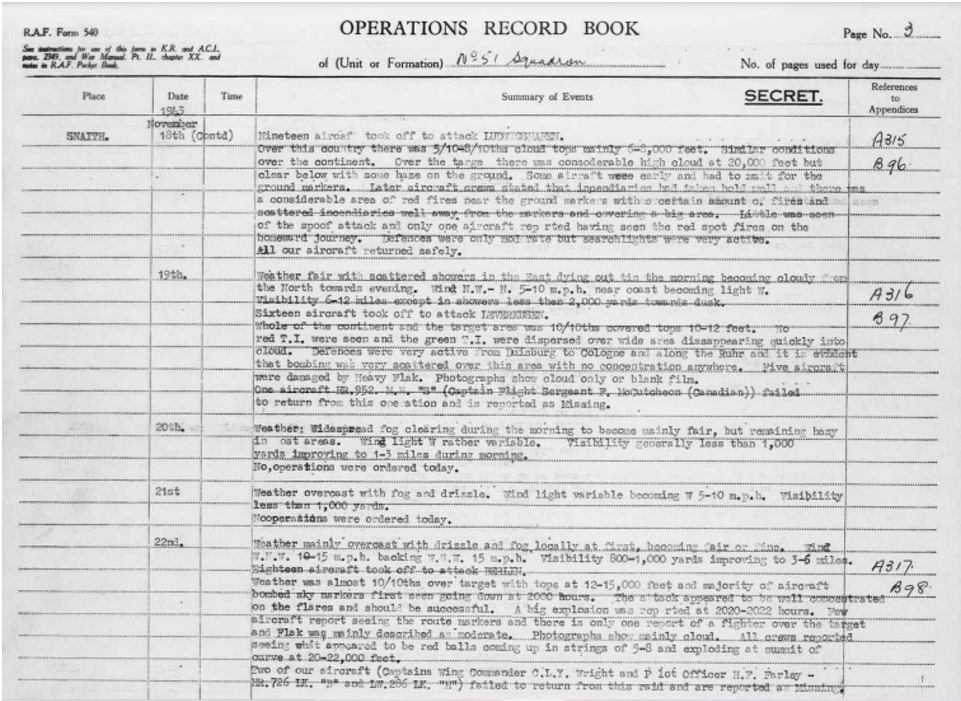
The entry for 22nd November 1943 is reproduced for ease of reading below:
‘Weather mainly overcast with drizzle and fog, locally at first, becoming fair or fine. Wind W.N.W. 10 – 15 m.p.h. backing W.S.W. 15 m.p.h. Visibility 800 – 1000 yards improving to 3 – 6 miles. Eighteen aircraft took off to attack BERLIN. Weather was almost 10/10ths over target with tops at 12 – 15,000 feet and majority of aircraft bombed sky markers first seen going down at 2000 hours. The attack appeared to be well concentrated on the flares and should be successful. A big explosion was reported at 2020 – 2022 hours. Few aircraft report seeing the route markers and there is only one report of a fighter over the target and Flack was mainly described as moderate. Photographs show mainly cloud. All crews reported seeing what appeared to be red balls coming up in strings of 5 – 8 and exploding at summit of curve at 20 – 22,000 feet.
Two of our aircraft (Captains Wing Commander C.L.Y. Wright and Pilot Officer H.F. Farley – HR726 LK. ‘B’ and LW286 LK ‘H’) failed to return from this raid and are reported as Missing.’ Official records show the reason for the loss of Uncle Ted’s aircraft as unknown, but further research carried out by us (Vera and Jim Duncan) narrows down the possible causes. The flight path took them over the Dutch island of Texel, the Ijsselmeer and Northern Netherlands. They were probably either hit by flak over Texel or intercepted by a night fighter, as their Halifax crashed in the Ijsselmeer between Urk and Hindelopen. The whole crew perished (source https://tinyurl.com/bdfzx5u4).
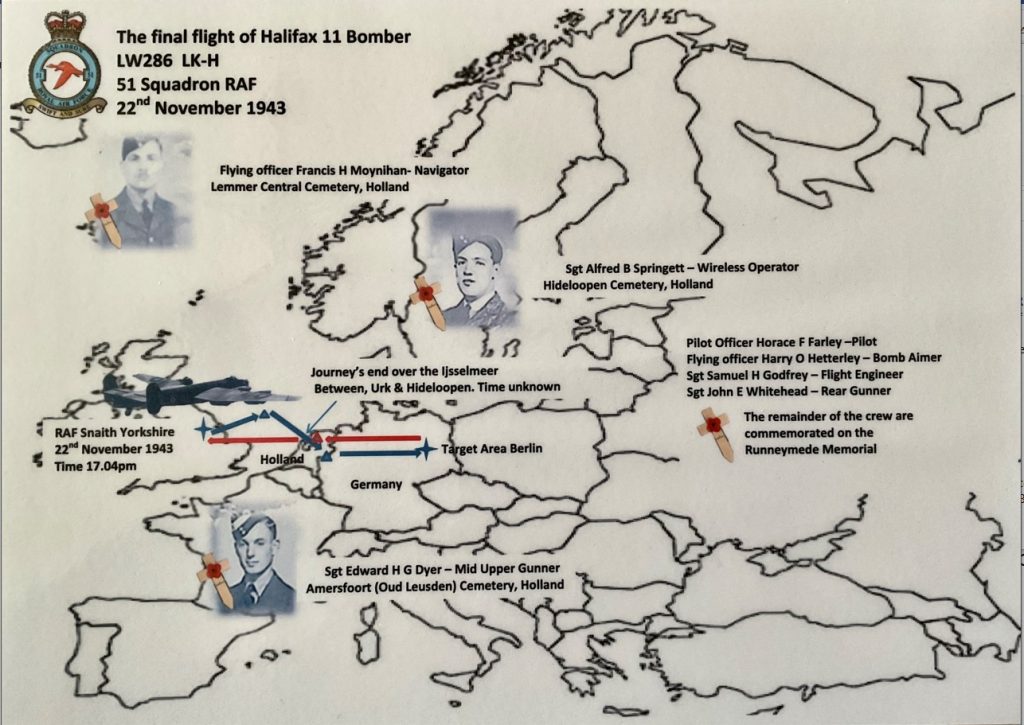
Only three of the crew members were recovered and later buried in Commonwealth War Graves:
Sgt Edward Harold George Dyer, Service Number 1606353, Mid Upper Gunner, aged 19, buried in Amersfoort Cemetery.
Sgt Alfred Bakes Springett, Service Number 1078608, Wireless Operator, aged 23, buried in Hindeloopen Cemetery.
Flying Officer Francis Henry Moynihan, Service Number 139959, Navigator, aged 23, buried in Lemsterland (Lemmer).
The bodies of the remaining four airmen were not found, and they are remembered with honour on the Runnymede Memorial:
Pilot Officer Horace Frank Farley, Service Number 159066, Pilot, aged 30 years.
Flying Officer Harry Oswald Hetterley, Service Number 131990, Bomb Aimer, aged 21 years.
Sgt John Eric Whitehead, Service Number 1333569, Rear Gunner, aged 20 years.
Sgt Samuel Henry Godfrey, Service Number 1272401, Flight Engineer, aged 21 years.
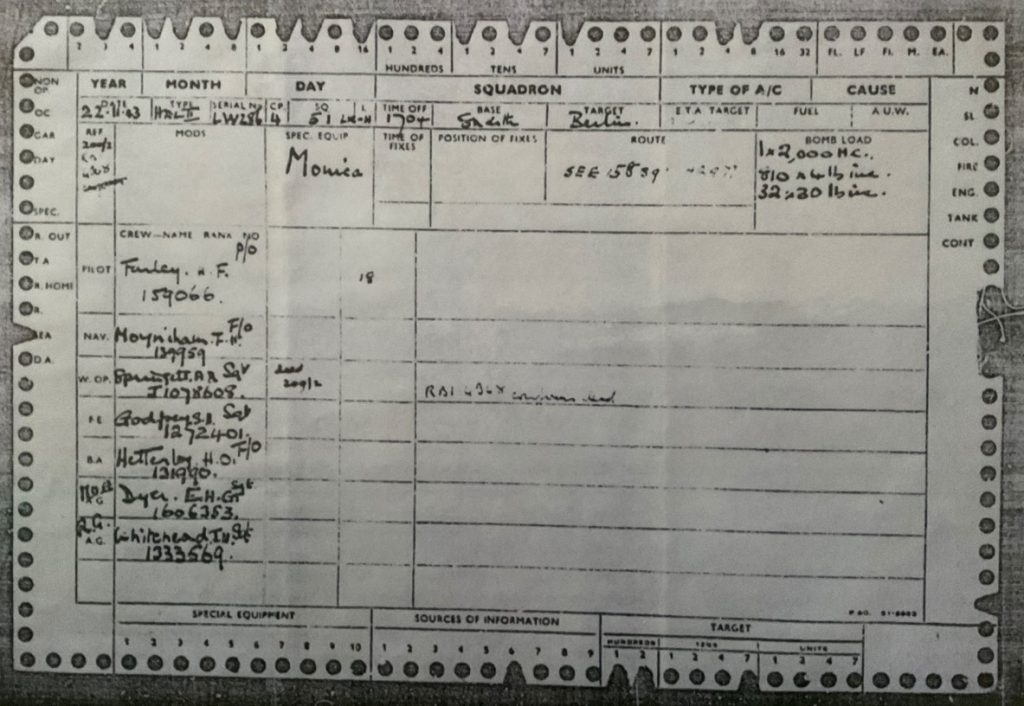
The ‘Flight’ publication dated 2nd December 1943 shows 26 British and US Air Losses over the continent for 22nd November 1943. Two of the 26 came from 51 Squadron that night. In a later issue on 3rd February 1944 Ted’s name appears in the Roll of Honour.
His death certificate shows: presumed dead on 22.11.43, being lost at sea; with a cause of death described as Air Operations. There were a couple of months between the aircraft being lost over Lake Ijssel (known as Ijsselmeer in Dutch) in Holland on 22nd/23rd Nov 1943 and his body being recovered from the water in January 1944. At that point he was still not identified, and was buried as an “Unknown Englishman” in Urk Cemetery Grave no 613(1). It wasn’t until 1946/7 that he was identified as Sgt Edward H.G. Dyer of the RAF/United Kingdom (UK) and then reburied in Amersfoort cemetery in July 1947, Row 9 Plot 13 Grave 188.
Not long after the war, his parents received a photograph from a lady in Holland showing Uncle Ted’s grave marked with a wooden cross. Later, this was replaced with a Commonwealth Graves Commission (CWGC) stone. In 2009, we found the graveyard in Amersfoort was very dark with overhanging trees and bushes, but the graves themselves were perfectly kept as usual. The CWGC had been in discussion with the Dutch authorities over many years to cut back the vegetation. Eventually agreement was made and work commenced, and it now looks so lovely and open to the sunshine.
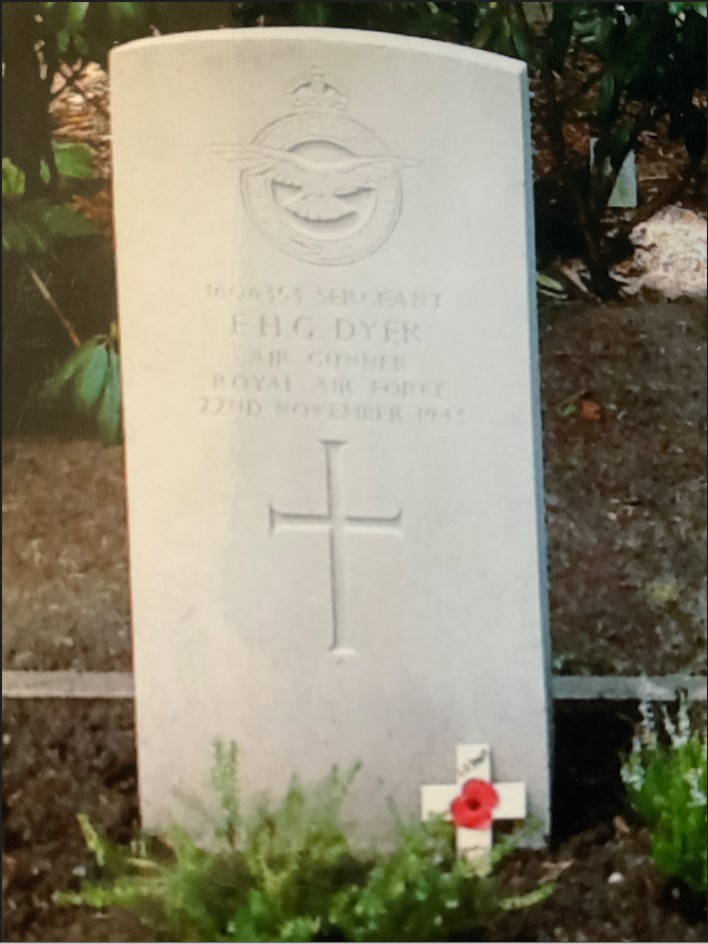
On 19th September 2012 we attended a Rededication Service carried out by the commission, attended by many dignitaries and relatives from the nations who have people buried there: two hundred and thirty-one casualties made up from aircrews from the UK, Australia, New Zealand, Poland, and Belgium. In addition, it includes a lone soldier from the Oxfordshire & Buckinghamshire Regiment, part of the Airborne Division, who drowned near to Arnhem during Operation Market Garden. Uncle Ted is remembered in several places in the UK too, along with many more lost air crews:
Pollington Airfield Memorial Garden (51 Squadron)
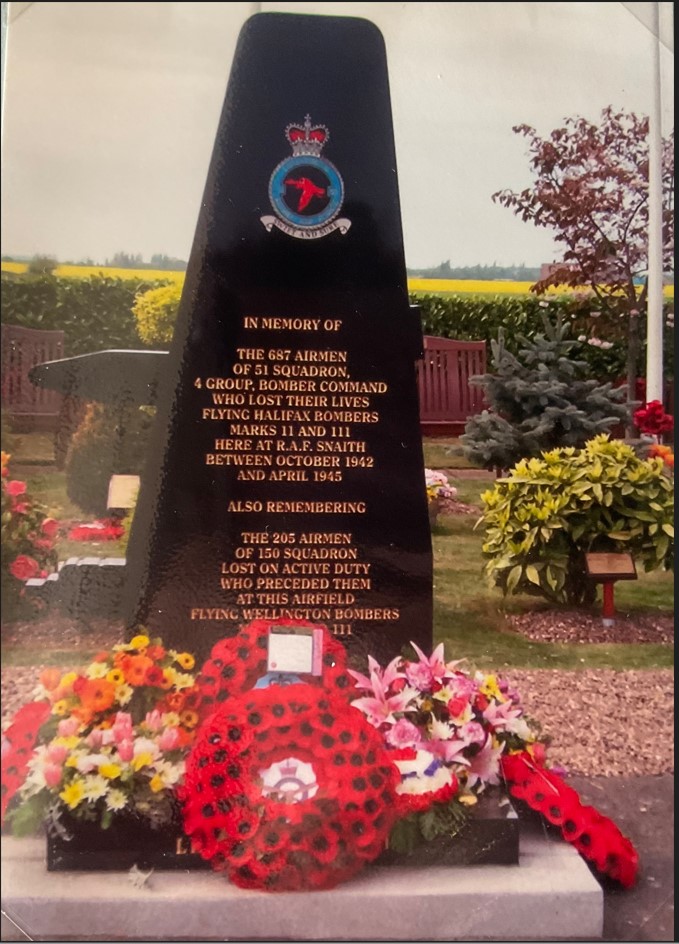
The garden is located on the site of the former station headquarters, this is a living memorial to all those 687 airmen of 51 Squadron, 4 Group, Bomber Command, who lost their lives flying Halifax Bombers Mark II and III between October 1942 – April 1945, who served at RAF Snaith, Yorkshire. There are individual plaques in memory of each a flight crew lost, listing their names, rank and date.
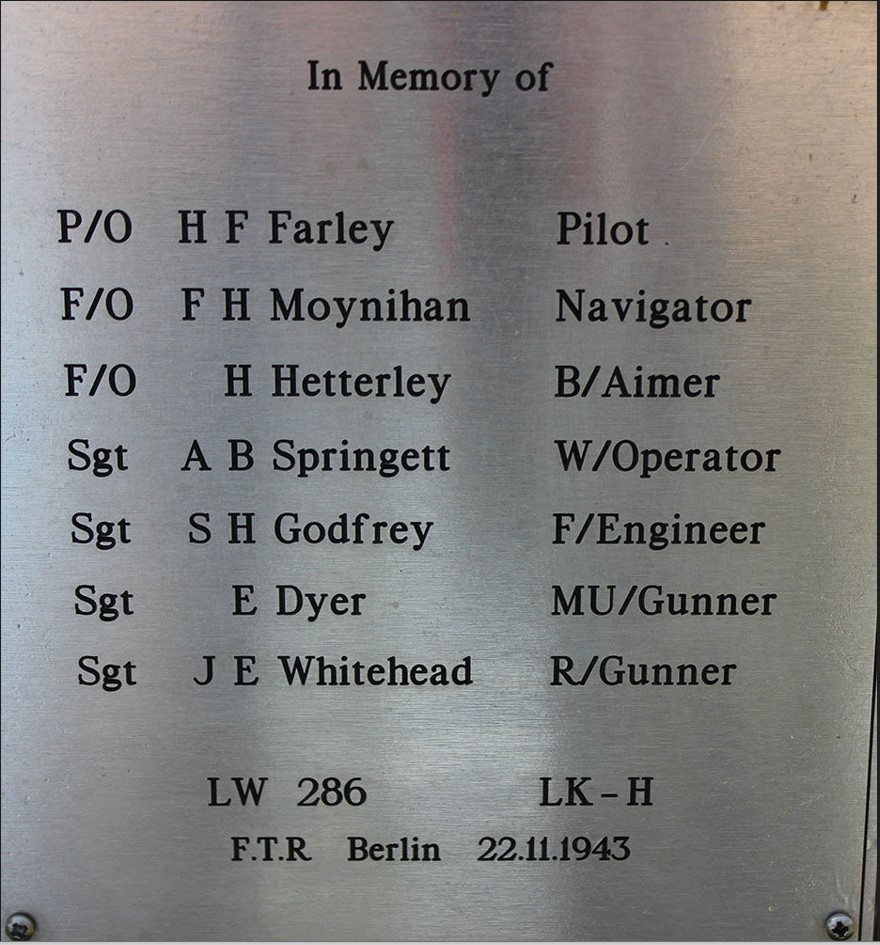
Bomber Command Memorial
Located in London Green Park, it is a tribute to the 55,573 Bomber Command Crew who lost their lives in World War 2. This was officially unveiled by Her Majesty the Queen on 28th June 2012. At the heart of the Memorial are the bronze sculptures of a Bomber Command Crew. The design of the roof incorporates sections of aluminium from a recovered Handley Page Halifax III Bomber (Serial Number LW682).
International Bomber Command Centre, Lincoln
The centre was opened to the public in 2018. The site is centred round the Memorial Spire and the Wall of Names. Uncle Ted’s name is inscribed as DYER EHG. The spire is the UK’s tallest memorial and is based on the dimensions of the wingspan of a Lancaster bomber – 102ft high and 16ft wide at the base.
Cullompton town War Memorial
This, like in many towns and villages, is dedicated to both World War 1 and World War 2, and sadly recent conflicts too. It has the inscription: Sergeant Air Gunner – E.H.G. DYER – Royal Air Force. Some of Uncle Ted’s friends he knew from childhood who also served between 1939 -1945 in the Army, RAF and Royal Navy, appear alongside his name.
St Andrews Parish Church, Cullompton
His name (E. DYER) had been added to the stained glass window by his parents, to sit beside his friends.
John McCallum and his father often talked about the young airman that they had met on the road bridge over the railway in Saltcoats, wondering what had become of him and if he had survived the war. Finally, at the age of 95 years, John’s questions were answered, and the three men were reunited in the only way possible, with John holding a photograph of his parents together with a photograph of Sgt Edward Dyer in the flying jacket that he probably wore that night:
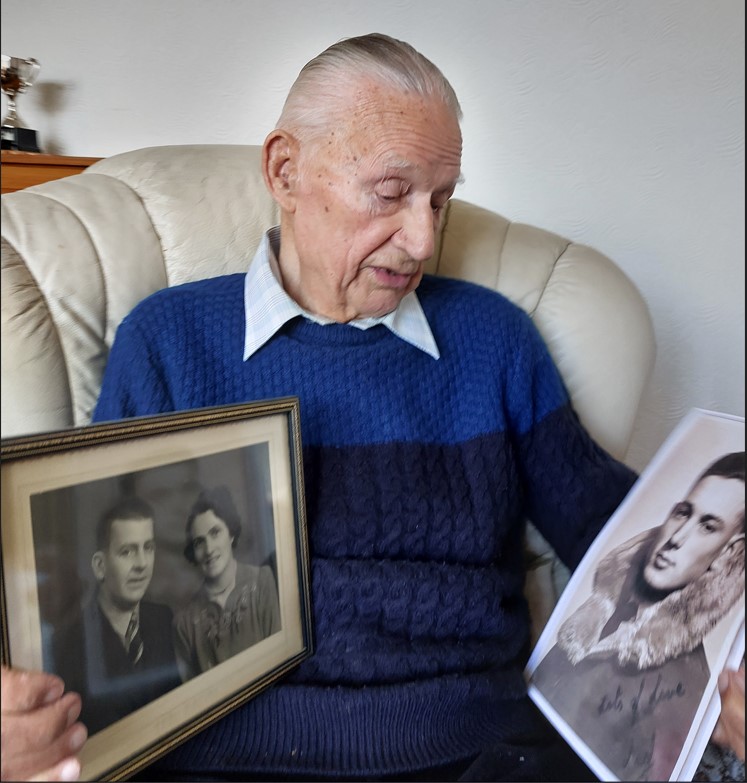
Finally, his life, and thousands more who lost their lives in conflict will be remembered, as long as we keep them in our hearts and talk about them.
THEIR NAME LIVETH FOR EVERMORE
This section of the website remembering Sgt Edward Dyer was rewritten in October 2023 to include extensive research findings, additional information and photographs not previously available on-line, which were generously shared with North Ayrshire Heritage by Vera and Jim Duncan. Vera is Sgt Edward Dyer’s niece, and she and Jim have been researching her Uncle Ted’s life for many years.
